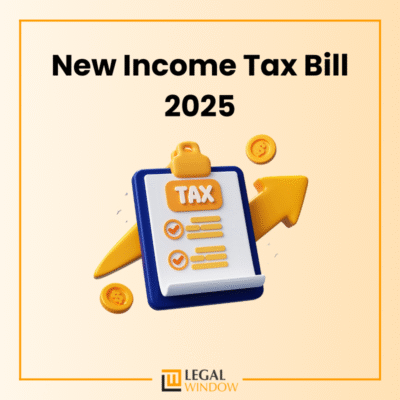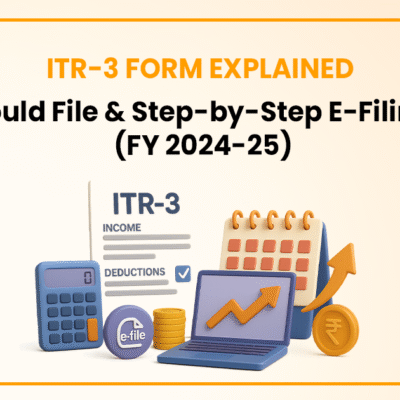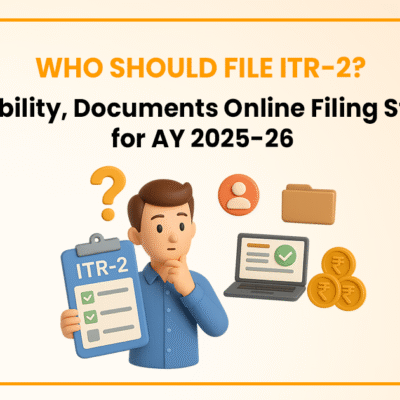ITR-1 (Sahaj) Filing Guide for FY 2024-25: Who Should File & How to E-File Step-by-Step (AY 2025-26)
- June 14, 2025
- Income Tax

Introduction
Generally, the tax season can often feel like a difficult task, filled with complex forms and confusing jargon. But what if we told you that for many Indian taxpayers, filing an income tax return is simpler than you think? If you are a salaried individual, receive pension income, or earn from a single house property, then ITR-1 (also known as SAHAJ) is likely the form designed for you. As the name suggests, this form provides ease in filing ITR.
Understanding ITR-1 Sahaj
As its name suggests, the ITR-1 Sahaj form offers a straightforward way for many individual taxpayers to fulfill their annual income tax obligations. It is designed to make the filing process as simple as possible for those who meet specific criteria.
This form is specifically for resident individuals in India whose total income for the financial year is below ₹50 lakhs. To be eligible for ITR-1, your income must come from a limited set of sources.
The ITR-1 form streamlines the process for eligible individuals, providing a convenient and efficient way to report their income and meet their tax responsibilities. It is truly a "Sahaj" (easy) way to file!
Who is eligible to file ITR 1?
An individual resident having a total income that does not exceed the value of 50 lakhs of rupees during the financial year and earning income from the below-mentioned sources needs to file ITR-1:
- Income is from salary, house property (one only), family pension income, agricultural income (which does not exceed Rupees 5,000), and other sources, which include:
- Interest received from Savings Accounts
- Interest earned from deposits (from bank/post office/cooperative society)
- Interest received from Income Tax Refund
- Interest earned on Enhanced Compensation
- Any other Interest Income earned
- Income from Family Pension
Clubbing of Income: Combining income with a spouse's or a minor's income is allowed only in case the source of income earned is the same as the limits mentioned above.
Income which shall not be the part of ITR 1 form
The following income shall not form part of ITR-1:
(a) Profits and gains from business and professions (PGBP)
(b) Short-term capital gains (STCG)
(c) Long-term capital gain (LTCG) u/s 112A exceeding Rs.1.25 lakhs
(d) Income earned from more than one house property
(e) Income earned from other sources that is of the following nature
(i) Income earned as winnings from the lottery
(ii) Income earned from the activity of owning and maintaining racehorses
(iii) Income that is taxable at special rates under section 115BBDA or section 115BBE
(f) Income to be apportioned in accordance with provisions of section 5A
Due date to file ITR-1
The due date to file ITR for FY 2024-25 (AY 2025-26) has been extended to September 15, 2025 from the original due date of July 31, 2025 for non-audit taxpayers. In case you miss filing within the prescribed due date, you can file a belated return by December 31, 2025 with penalties and interest.
It is recommended to file ITR 1 before the due date to avoid penalties and non-compliance.
ITR Sahaj forms are attachment-less forms, i.e., taxpayers are not needed to annex any documents.
Documents required to file ITR-1
Taxpayers should keep the following documents for their records and be prepared to produce the same before tax authorities if requested.
- Form 16: Provided by all your employers for the relevant financial year.
- Form 26AS: Ensure that the TDS details in Form 16 match those in Part A of Form 26AS.
- Receipts: Retain receipts for exemptions or deductions (e.g., HRA allowance or Section 80C/80D deductions) not submitted to your employer on time to claim them directly on your income tax return.
- PAN Card: Your Permanent Account Number (PAN) card is essential for identification.
- Bank Investment Certificates: Statements providing details of interest earned from bank accounts, such as bank passbooks or fixed deposit certificates.
- Point for consideration: The income tax department has made it mandatory for all taxpayers to link their Aadhar card with their PAN on the income tax department website.
Changes in ITR-1 (AY 2025-26)
For the Assessment Year (AY) 2025-26 (FY 2024-25), there are many important changes in ITR 1 that taxpayers, especially salaried individuals, should be aware of, including the important changes made by the Department of Income Tax. The Income Tax Department has introduced enhanced disclosure requirements and validation rules to ensure more accurate and transparent tax reporting.
Here are the key changes in ITR 1 for AY 2025-26:
- Wider Eligibility for ITR 1:
Long-Term Capital Gains (LTCG) under Section 112A: Earlier, any capital gains disqualified taxpayers from using ITR 1, but now, individuals earning LTCG up to 1.25 lakh rupees from the sale of equity shares that are listed on stock exchanges or equity mutual funds under Section 112A can file ITR 1. This is a crucial relief for small investors.
Important Note: This is only applicable if there are no carried forward or brought forward capital losses. If your LTCG exceeds ₹1.25 lakh, or in case you have other types of capital gains or losses to carry forward, you will still be required to use ITR-2 or other appropriate forms as the case may be.
- Enhanced Disclosure for Deductions (for those opting for the Old Tax Regime): The ITR 1 utility now requires more detailed information for various deductions to eliminate the false claims and streamline processing. You are required to keep supporting documents ready. The list of the documents is as follows:
- House Rent Allowance: Taxpayers claiming HRA exemption should have to provide comprehensive details including
- Place of Work
- Actual HRA Received
- Actual Rent Paid
- Basic Salary and Dearness Allowance
- Information that whether the city is metro or non-metro
- Name of landlord and PAN (if amount of annual rent exceeds rupees 1 lakh)
- Section 80C Deductions: For investments like PPF, ELSS, NSC, life insurance, etc., you have to disclose the nature of the investment, the amount of investment, and the policy number or document identification number, as the case may be to claim a deduction under section 80C.
- Section 80D (Health Insurance Premium): You are required to provide the name of the insurance company and the policy or document number.
- Section 80E (Education Loan Interest): Mandatory details, which include
- Lender’s Name
- Name of the Bank
- Loan Account Number
- Date of Sanction of Loan
- Total amount of Loan
- Loan amount outstanding as of March 31
- Interest Amount Paid
- Section 80EE/80EEA (Interest on Home Loan): Similar disclosures as Section 80E are needed, including lender's name, bank name, loan account number, date of sanction, total loan amount, and outstanding balance.
- Section 80EEB (Interest on Electric Vehicle Loan): Similar detailed disclosures as other loan-related deductions.
- Section 80DDB (Medical Treatment of Specified Diseases): The name of the disease being treated is now a mandatory field while claiming deduction under section 80DDB.
- Section 80GG (Rent Paid where HRA is not received): It is now compulsory to file a declaration in Form No. 10BA accompanied by the return of income.
- Mandatory Mention of TDS Sections:
Taxpayers are now required to mention the section under which TDS was deducted for income sources (e.g., Section 192 for salary, Section 194A for interest income, etc.). This ensures the cross-checking of TDS credits with Form 26AS.
- Aadhaar Enrollment ID No Longer Accepted:
From AY 2025-26, Aadhar Card is mandatory, and PAN applications and ITR filings cannot be processed using the Aadhaar Enrollment ID. Taxpayers have to provide an actual Aadhaar number. The field for Aadhaar Enrollment ID has been removed from all ITR forms, and hence Aadhaar Enrollment ID is no longer accepted.
- Smarter Excel Utility with Error Detection:
The Excel utilities for ITR 1 come with real-time validation, smarter error detection, and section-wise instructions, reducing manual errors. This is making the form more efficient.
- Extended Due Date for Filing ITR:
For non-audit taxpayers, the due date for filing ITR for FY 2024-25 (AY 2025-26) has been extended to September 15, 2025, from the original July 31, 2025. The deadline for filing a belated or revised return is December 31, 2025.
Important Note: The Income Tax Department is focusing on greater transparency and preventing false claims. Therefore, it is crucial for taxpayers to maintain all relevant documents and proofs for deductions claimed, as these might be cross-verified. While Form 16 provides a summary, additional detailed proof is now required for certain deductions if you opt for the old tax regime.

Take away
Understanding ITR-1 (Sahaj) filing for FY 2024-25 (AY 2025-26) ensures compliance and simplifies your tax journey. Remember to verify pre-filled data, understand the default new tax regime, and claim eligible deductions accurately. With the extended due date of September 15, 2025. For a smooth and error-free experience. Do not forget to consider leveraging professional guidance from the experts team at Legal Window ensuring your Income tax compliances.
LegalWindow.in is a professional technology driven platform of multidisciplined experts like CA/CS/Lawyers spanning with an aim to provide concrete solution to individuals, start-ups and other business organisation by maximising their growth at an affordable cost. Our team offers expertise solutions in various fields that include Corporate Laws, Direct Taxations, GST Matters, IP Registrations and other Legal Affairs.
Categories
- Agreement Drafting (23)
- Annual Compliance (13)
- Change in Business (37)
- Company Law (150)
- Compliance (90)
- Digital Banking (3)
- Drug License (4)
- FEMA (17)
- Finance Company (42)
- Foreign Taxation (9)
- FSSAI License/Registration (15)
- GST (124)
- Hallmark Registration (1)
- Income Tax (214)
- Latest News (36)
- Miscellaneous (170)
- NBFC Registration (8)
- NGO (18)
- SEBI Registration (6)
- Section 8 Company (10)
- Start and manage a business (27)
- Startup/ Registration (134)
- Trademark Registration/IPR (48)
Recent Posts
- Major Upgrade: Breaking Down GST 2.0 September 15, 2025
- New Income Tax Bill 2025 August 27, 2025
- ITR-3 Form Explained: Who Should File & Step-by-Step E-Filing Guide (FY 2024-25) June 25, 2025
All Website Tags
About us
LegalWindow.in is a professional technology driven platform of multidisciplined experts like CA/CS/Lawyers spanning with an aim to provide concrete solution to individuals, start-ups and other business organisation by maximising their growth at an affordable cost.








